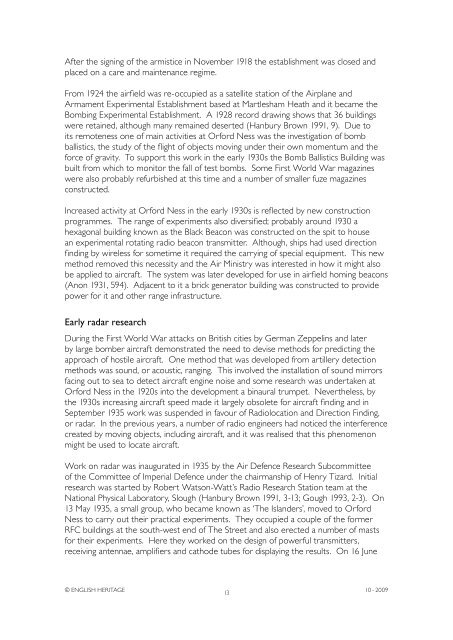Atomic Weapons Research Establishment. Orford ... - English Heritage
Atomic Weapons Research Establishment. Orford ... - English Heritage
Atomic Weapons Research Establishment. Orford ... - English Heritage
Create successful ePaper yourself
Turn your PDF publications into a flip-book with our unique Google optimized e-Paper software.
After the signing of the armistice in November 1918 the establishment was closed and<br />
placed on a care and maintenance regime.<br />
From 1924 the airfield was re-occupied as a satellite station of the Airplane and<br />
Armament Experimental <strong>Establishment</strong> based at Martlesham Heath and it became the<br />
Bombing Experimental <strong>Establishment</strong>. A 1928 record drawing shows that 36 buildings<br />
were retained, although many remained deserted (Hanbury Brown 1991, 9). Due to<br />
its remoteness one of main activities at <strong>Orford</strong> Ness was the investigation of bomb<br />
ballistics, the study of the flight of objects moving under their own momentum and the<br />
force of gravity. To support this work in the early 1930s the Bomb Ballistics Building was<br />
built from which to monitor the fall of test bombs. Some First World War magazines<br />
were also probably refurbished at this time and a number of smaller fuze magazines<br />
constructed.<br />
Increased activity at <strong>Orford</strong> Ness in the early 1930s is reflected by new construction<br />
programmes. The range of experiments also diversified; probably around 1930 a<br />
hexagonal building known as the Black Beacon was constructed on the spit to house<br />
an experimental rotating radio beacon transmitter. Although, ships had used direction<br />
finding by wireless for sometime it required the carrying of special equipment. This new<br />
method removed this necessity and the Air Ministry was interested in how it might also<br />
be applied to aircraft. The system was later developed for use in airfield homing beacons<br />
(Anon 1931, 594). Adjacent to it a brick generator building was constructed to provide<br />
power for it and other range infrastructure.<br />
Early radar research<br />
During the First World War attacks on British cities by German Zeppelins and later<br />
by large bomber aircraft demonstrated the need to devise methods for predicting the<br />
approach of hostile aircraft. One method that was developed from artillery detection<br />
methods was sound, or acoustic, ranging. This involved the installation of sound mirrors<br />
facing out to sea to detect aircraft engine noise and some research was undertaken at<br />
<strong>Orford</strong> Ness in the 1920s into the development a binaural trumpet. Nevertheless, by<br />
the 1930s increasing aircraft speed made it largely obsolete for aircraft finding and in<br />
September 1935 work was suspended in favour of Radiolocation and Direction Finding,<br />
or radar. In the previous years, a number of radio engineers had noticed the interference<br />
created by moving objects, including aircraft, and it was realised that this phenomenon<br />
might be used to locate aircraft.<br />
Work on radar was inaugurated in 1935 by the Air Defence <strong>Research</strong> Subcommittee<br />
of the Committee of Imperial Defence under the chairmanship of Henry Tizard. Initial<br />
research was started by Robert Watson-Watt’s Radio <strong>Research</strong> Station team at the<br />
National Physical Laboratory, Slough (Hanbury Brown 1991, 3-13; Gough 1993, 2-3). On<br />
13 May 1935, a small group, who became known as ‘The Islanders’, moved to <strong>Orford</strong><br />
Ness to carry out their practical experiments. They occupied a couple of the former<br />
RFC buildings at the south-west end of The Street and also erected a number of masts<br />
for their experiments. Here they worked on the design of powerful transmitters,<br />
receiving antennae, amplifiers and cathode tubes for displaying the results. On 16 June<br />
© ENGLISH HERITAGE<br />
13<br />
10 - 2009

















